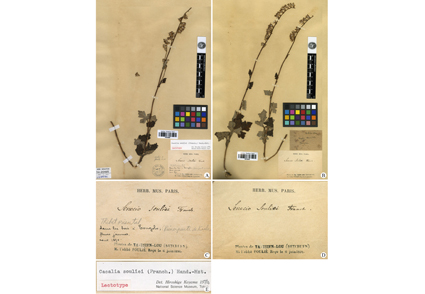Abstract
The problems about the original material and typifications of Senecio plantaginifolius (= Ligularia virgaurea), S. setchuenensis (≡ Synotis setchuenensis), and S. souliei (≡ Parasenecio souliei) have been revisited. The correct lectotype of S. souliei is the P00705033 sheet of Soulié s.n. designated by Koyama (Acta Phytotax. Geobot. 30: 75. 1979), and that of S. plantaginifolius should be Soulié s.n. (P02676722) designated by Hu (Quart. J. Taiwan Mus. 21: 137. 1968). For S. setchuenensis, it is better to only accept the P00705011 and P00705012 sheets of Soulié 198 as its original material, and the lectotype is P00705011 designated by Yu et al. (Pl. Diversity Resources 36: 593. 2014).
References
Chen, Y.S. (2015) Asteraceae II, Saussurea. In: Hong, D.Y. (Ed.) Flora of Pan-Himalaya, vol. 48 (2). Science Press, Beijing, 340 pp.
Franchet, A. (1891) Diagnoses d’espèces nouvelles provenant d’une collection de plantes du Thibet chinois envoyée au muséum par M. l’Abbé Soulié. Bulletin de la Société Philomatique de Paris 3: 140–150.
Franchet, A. (1892) Les genres Ligularia, Senecillis, Cremanthodium et leurs espèces dans l’Asie centrale et orientale. Bulletin de la Société Botanique de France 39: 279?307. https://doi.org/10.1080/00378941.1892.10828665
Hu, X.Y. (1967) The Compositae of China (V). Quarterly Journal of the Taiwan Museum 20: 1–77. https://doi.org/10.1111/j.1468-0033.1967.tb01649.x
Hu, X.Y. (1968) The Compositae of China (VIII). Quarterly Journal of the Taiwan Museum 21: 127–179.
Illarionova, I.D. (2006) Genus Ligularia Cass. (Asteraceae) in Asia Centrali. Novitates Systematicae Plantarum Vascularium 38: 229–244. [In Russian]
Jeffrey, C. & Chen, Y.L. (1984) Taxonomic studies on the tribe Senecioneae (Compositae) of Eastern Asia. Kew Bulletin 39: 205–446. https://doi.org/10.2307/4110124
Koyama, H. (1979) Notes on some species of Chinese Cacalia 3. Acta Phytotaxonomica et Geobotanica 30: 65–84.
Maximowicz, C.J. (1881) Diagnoses plantarum novarum asiaticarum. IV. Mélanges Biologiques tirés du Bulletin de l’Aadémie Imperiale des Sciences de St.-Pétersbourg 11: 155–350.
Rehder, A. & Kobuski, C.E. (1933) An enumeration of the herbaceous plants collected by J. F. Rock for the Arnold Arboretum. Journal of the Arnold Arboretum 14: 1–52. https://doi.org/10.5962/p.250120
Yu, W.B., Wang, H. & Li, D.Z. (2013) Proposal to conserve Pedicularis stenocorys against P. stenantha (Orobanchaceae). Taxon 62: 1066–1067. https://doi.org/10.12705/625.33
Yu, W.B., Wang, H. & Li, D.Z. (2014) Typification of sixteen plant names described by Franchet in 1891. Plant Diversity and Resources 36: 590–594.


